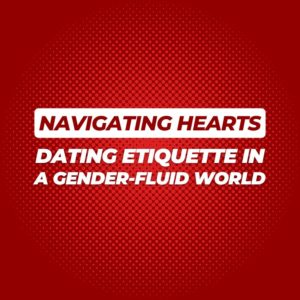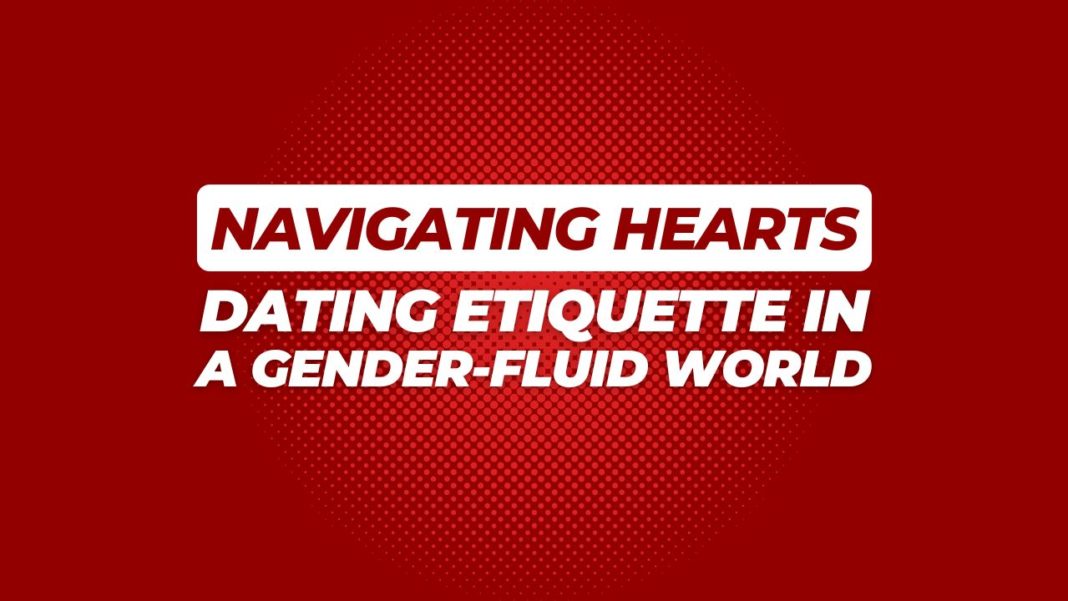Introduction to Gender-Fluid Dating
In today’s rapidly evolving social landscape, the norms and expectations surrounding dating are continually transforming. As society grows increasingly aware of gender fluidity, traditional concepts of “his and hers” are giving way to a more inclusive approach to relationships. This shift is not just about acknowledging diverse gender identities but also about embracing a spectrum of romantic and personal connections that transcend conventional labels.
relationships. This shift is not just about acknowledging diverse gender identities but also about embracing a spectrum of romantic and personal connections that transcend conventional labels.
The essence of dating in a gender-fluid world is rooted in the principles of inclusivity and understanding. It requires a paradigm shift from the traditional binary perspectives to a broader, more accepting view that recognises and respects individual identities. This inclusivity isn’t just politically correct; it’s a foundation for deeper, more meaningful relationships. By fostering an environment where people feel safe and supported to express their true selves, we cultivate a dating culture that celebrates diversity and enriches interactions.
As we navigate this new terrain, the importance of understanding cannot be overstated. Each person’s experience with gender is unique, and appreciating this diversity can lead to more empathetic and fulfilling relationships. This introduction to modern dating etiquette aims not only to inform but also to empower readers to cultivate a respectful and affectionate approach to love, regardless of gender. As we delve into this topic, we’ll explore practical ways to communicate, respect boundaries, and create inclusive dating experiences that honour everyone’s identity.
Understanding Gender Fluidity
Gender fluidity is a concept within the broader spectrum of gender diversity, where an individual’s gender identity is not fixed and can change over time, depending on the person’s experiences, feelings, and the context they find themselves in. Unlike more static definitions of gender, being gender fluid means one might feel more masculine on some days, more feminine on others, or a mixture of both—or even neither, embodying a non-binary or genderqueer identity.
This fluidity challenges the traditional binary notion of gender as strictly male or female, opening up a myriad of possibilities for how individuals perceive themselves and choose to express their identities. It’s crucial for society to recognise that gender fluidity is a legitimate expression of human diversity, deserving of the same respect and recognition as any other gender identity.
Influence on Personal Identity and Dating Preferences
For gender-fluid individuals, this dynamic aspect of their identity can significantly influence their approach to dating and relationships. Their dating preferences and attractions may shift along with their gender identity, which can be fluid and changing. This means that the qualities and characteristics that attract them to others might vary over time, which adds a layer of complexity to their dating life.
In the dating world, this fluidity can lead to a deeper understanding of the spectrum of human attraction. Gender-fluid individuals might find themselves attracted to different people, depending on their own current state of gender identity. This doesn’t necessarily mean inconsistency but rather a rich, varied experience of connection that reflects the fluid nature of their identity.
Navigating dating and relationships, therefore, requires clear communication from all parties involved. It’s vital for gender-fluid people and their potential partners to discuss their identities and expectations openly. This openness helps ensure that relationships are built on mutual understanding and respect, accommodating the fluid aspects of identity in ways that traditional dating norms might not.
Understanding gender fluidity enriches the dating experience by fostering a culture that values flexibility, openness, and the rejection of rigid labels. It challenges both the gender-fluid individual and their partners to think beyond the conventional and to embrace a more nuanced understanding of human relationships. This approach not only supports gender-fluid people but also enhances the dating landscape by encouraging a more inclusive and empathetic understanding of love and attraction.
Communication is Key
In the evolving landscape of modern dating, open and honest communication serves as the cornerstone of understanding and respecting each partner’s gender identity and boundaries. This level of transparency is crucial in fostering a relationship where all parties feel seen, heard, and respected.
The Importance of Open and Honest Communication
Effective communication allows each individual to express their identity authentically and safely, ensuring that all interactions are based on mutual respect and understanding. For gender-fluid individuals, whose gender expression may vary, it’s especially important that their partners are aware and supportive of these changes. Discussing one’s gender identity isn’t just about sharing pronouns; it’s about conveying personal experiences and feelings that shape one’s identity. This dialogue helps prevent assumptions and misunderstandings that can lead to discomfort or emotional disconnect in a relationship.
Tips on Initiating Conversations About Gender Identity and Pronouns
Choose the Right Moment: Begin these conversations in a private, relaxed setting where both parties feel safe and undistracted. It’s important to ensure that the timing feels appropriate and that there is enough space for a thorough discussion.
Express Your Intentions: Clearly state that your goal is to respect and understand them better. You might start with phrases like, “I want to make sure I address you correctly and understand your perspective…”
Invite Sharing with Open-Ended Questions: Use open-ended questions to encourage your partner to share their thoughts and feelings. For instance, you could ask, “How do you prefer to describe your gender identity?” or “What should I know about your preferences and pronouns?”
Share Your Own Experiences and Boundaries: Reciprocity can make these conversations more comfortable. Sharing your own views and experiences with gender can help create a mutual understanding and demonstrate your openness.
Be Patient and Attentive: Recognise that these conversations may be challenging or emotional. Show patience and give your partner time to express themselves fully. Active listening is key—this means listening to understand, not just to respond.
Educate Yourself: Before initiating these conversations, it’s helpful to educate yourself on basic terms and concepts related to gender identity. This shows respect and reduces the burden on gender-fluid individuals to explain basic concepts during what should be a personal discussion.
Follow Up: These discussions aren’t just one-time conversations. Check in periodically to see if anything has changed or if there are new preferences or boundaries to consider. This ongoing dialogue underscores that you care about their comfort and identity as the relationship progresses.
Respecting Boundaries
Establishing and respecting personal and emotional boundaries is essential in any relationship, but it holds particular importance in the context of dating in a gender-fluid world. Boundaries help define what individuals are comfortable with in terms of their personal space, emotional expression, and the pace at which a relationship progresses.
The Significance of Boundaries
Boundaries are vital because they protect an individual’s emotional well-being and foster a mutual respect that is crucial for any healthy relationship. They help each person feel safe and respected. Particularly for gender-fluid individuals, whose needs and comfort levels might change, clear boundaries ensure that these variations are respected and met with understanding rather than resistance.
Examples of Setting Healthy Boundaries in a Relationship
Communicating Limits Clearly: From the outset, be clear about what is and isn’t acceptable within the relationship. For instance, if a person is uncomfortable with certain types of physical affection at various times, they should feel free to express this. A simple statement can be, “I’m not always comfortable with public displays of affection, especially when I’m feeling more introverted.”
Emotional Boundaries: It’s important to let your partner know how you prefer to receive support during emotional times. A boundary here could be, “When I talk about my experiences with gender, I need you to listen first rather than offering solutions right away.”
Time Boundaries: Respecting each other’s time and the need for personal space is crucial. This could be communicated by saying, “I value our time together, but I also need certain days to focus on myself and my needs alone.”
Digital Communication Boundaries: Setting expectations about frequency and modes of communication can prevent feelings of being overwhelmed or neglected. For example, one might say, “I prefer not to text all day because it distracts from my work and personal time. Can we check in during the evening instead?”
Discussing Future Plans: It’s essential to respect each partner’s comfort level with discussions about the future. Setting a boundary might look like, “I’m not ready to discuss moving in together or long-term commitments yet. Let’s revisit this conversation in a few months.”
Consent and Physical Boundaries: Always ensure that consent is explicit and ongoing, particularly in intimate situations. A respectful way to address this could be, “I want to check in with you before we move forward to make sure you’re still comfortable.”
Flexibility with Gender-related Needs: Given the fluidity of gender identity, partners should establish how they can support each other’s changing needs regarding gender expression. This could be framed as, “As my feelings about my gender can change, I might need different types of support from you. Let’s talk openly about what that could look like.”
Inclusive Dating Ideas
Creating a dating environment that is inclusive and enjoyable for everyone, regardless of gender identity, involves selecting activities that do not assume specific gender roles or preferences. Here are some gender-neutral dating ideas along with tips on how to ensure that these dates are comfortable and enjoyable for all participants.
Gender-Neutral Dating Activities
Artistic Workshops: Participate in a pottery, painting, or craft class together. These activities allow for creative expression and can be enjoyed by anyone, regardless of gender.
Outdoor Adventures: Plan a day out hiking, biking, or exploring a local botanical garden. These activities are great for getting to know each other in a relaxed, natural setting.
Cooking Classes: Whether it’s learning to make sushi or baking pastries, cooking classes are a fun way to collaborate and enjoy the fruits of your labour together.
Cultural Exploration: Visit museums, art galleries, or historical sites. These outings are not only educational but also stimulate interesting conversations.
Game Night: Organise a game night with a mix of board games, card games, and video games. It’s a light-hearted way to engage and bond over shared fun.
Volunteering: Spend a day volunteering at a local charity or community event. This can be a meaningful way to see each other’s compassionate side and discuss shared values.
Ensuring Comfort and Enjoyment
Discuss Preferences Beforehand: Have a conversation about interests and comfort zones before planning the date. This ensures that the activity chosen is enjoyable for both and does not inadvertently cause discomfort.
Choose Accessible Locations: Ensure that the venue is accessible to everyone. This includes considering physical accessibility, as well as sensory-friendly environments for those who might be overwhelmed by loud or crowded spaces.
Be Flexible with Plans: Always be willing to adjust plans if they seem to be causing discomfort. Flexibility shows that you value your date’s comfort over sticking rigidly to a schedule.
Create a Judgement-Free Zone: Encourage open dialogue where both parties can express if they’re not enjoying an activity without fear of judgement. This can help pivot to something more enjoyable for both.
Check-In Regularly: Throughout the date, casually check in with your partner to ensure they are comfortable and enjoying themselves. Simple questions like, “How are you finding the exhibition?” can open up opportunities for feedback.
Avoid Stereotypes: Choose activities that do not enforce traditional gender roles, such as assuming one person must lead or pay. This can make the date feel more inclusive and respectful of individual identities.
Overcoming Challenges
Dating can present unique challenges for gender-fluid individuals, from navigating societal expectations to personal identity fluctuations. Understanding these challenges and exploring strategies to overcome them is crucial for fostering supportive, fulfilling relationships.
Common Challenges Faced by Gender-Fluid Individuals in Dating
Misunderstanding and Lack of Awareness: Often, potential partners may not understand what being gender-fluid means, leading to miscommunications and discomfort.
Fluidity Misinterpretation: Partners might struggle with the concept that someone’s gender identity can change over time, which can lead to misunderstandings or unrealistic expectations about consistency in the relationship.
Social Stigma and Discrimination: Gender-fluid individuals can face stigma, discrimination, or even hostility in dating scenarios, which can lead to anxiety and reluctance to engage in the dating scene.
Internal Conflicts and Pressure: Navigating one’s fluctuating identity while trying to meet a partner’s needs can be stressful and emotionally draining.
Difficulty in Finding Compatible Partners: It can be challenging to find partners who are open and adaptable to the fluidity of gender identity.
Strategies for Overcoming These Challenges
Education and Open Dialogue: Educating oneself and potential partners about gender fluidity can pave the way for more informed and empathetic interactions. Encourage open dialogue from the start of the relationship to set a foundation of understanding and respect.
Seeking Supportive Communities: Engaging with communities that support gender fluidity can provide a safer space for dating and sharing experiences. These communities can offer both social and emotional support, reducing feelings of isolation.
Setting Clear Boundaries: Clearly communicating one’s needs, boundaries, and expectations can help prevent misunderstandings and ensure both partners feel respected and understood.
Using Inclusive Dating Platforms: Utilise dating platforms that cater to or are friendly towards the LGBTQ+ community, as these are more likely to attract open-minded individuals who are either experiencing similar challenges or are empathetic to them.
Regular Check-ins: Regularly checking in with each other’s feelings and comfort levels can help both partners stay aligned and responsive to each other’s changing needs and identities.
Couples Therapy or Counselling: For couples facing ongoing challenges, seeking professional help from therapists who specialise in LGBTQ+ issues can be beneficial. Therapy provides a safe space to explore complex feelings and develop strategies to strengthen the relationship.
Building Emotional Resilience: Developing personal coping strategies to deal with societal pressures and discrimination is crucial. This might include practicing self-care, engaging in mindfulness, or connecting with mentors within the gender-fluid community.
Celebrating Diversity: Embracing and celebrating the diversity within the relationship can transform challenges into strengths. Recognising and valuing each other’s unique perspectives and experiences can enrich the relationship.
Conclusion
The journey of modern dating in a gender-fluid world underscores the vital importance of inclusivity and respect. As society continues to evolve and acknowledge diverse gender identities, the norms of dating also adapt, fostering an environment where all individuals can express themselves authentically and find meaningful connections.
The Importance of Inclusivity and Respect
Inclusivity isn’t just about acknowledging differences—it’s about actively respecting and embracing them. This approach enriches the dating experience by allowing everyone, regardless of their gender identity, to feel valued and understood. Respect is the cornerstone that ensures all interactions are conducted with dignity, allowing relationships to flourish on a foundation of mutual appreciation and understanding.
Encouragement to Embrace Diverse Dating Experiences
Diverse dating experiences offer a unique opportunity to deepen our connections and broaden our understanding of the human experience. By stepping outside traditional dating norms, individuals open themselves up to a world of enriching interactions that challenge preconceived notions and expand personal horizons. This not only enhances personal growth but also cultivates a more empathetic and interconnected society.
As we navigate the complexities of dating in a gender-fluid world, let us take these lessons to heart:
- Strive for open communication to foster understanding and trust.
- Set and respect boundaries to ensure all parties feel comfortable and supported.
- Choose inclusive activities that affirm each person’s identity.
- Face challenges together, using them as opportunities to strengthen relationships and enhance mutual understanding.
By embracing this inclusive approach, we not only enrich our own lives but also contribute to a more compassionate and understanding world. Let us celebrate the diversity of human relationships and the myriad ways love can manifest, remembering that every heart deserves the chance to love and be loved, unconditionally and respectfully. And be sure to check out more dating advice at Online Dating UK.






